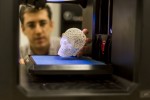The black, cube-shaped 3-D printer hummed as lasers stacked thin layers of plastic-infused white filament upon each other, giving 3-D life to a 2-D design. After the printer completed its job, Doug Daniels removed a lattice-patterned skull from the platform.
The printer, located on the second floor of Charles E. Young Research Library, was only available to staff and select students. Last week, library officials announced a pilot program that will allow students and faculty to use the MakerBot Replicator 3-D printer for their own design, art and research projects. Applicants can email proposals to the library’s main address.
More than 10 people have submitted proposals as of Monday, said Daniels, a technical project specialist at Young Research Library. One group of students wants to print parts for their engineering project, and three faculty members have requested 3-D printing demonstrations for their classes, he added.
Daniels said Campus Library Instructional Computing Commons funded the about $3,000 printer. Students contribute to CLICC funds through tuition fees.
The Henry Samueli School of Engineering and Applied Science and Design | Media Arts department offer 3-D printers, but the equipment they have is usually limited to classes whose students pay lab fees, said Jonathan Wilson, a UCLA Library research technology and support coordinator.
The low accessibility of these printers limits professors who want to integrate 3-D printing projects into their curriculum, he added.
Daniels said the library printers, though high-quality, are intended to allow students to test their projects’ prototypes and the functionality of their pieces before taking them to more costly, advanced printers within the School of Engineering and Design | Media Arts department.
Jessica Mentesoglu, manager of learning and research technology support and services for the Library, said she brought the idea of 3-D printing to UCLA after attending an international convention on education in 2014.
“We realized that the maker-space movement – the ability to use your hands to create things – is taking off in education,” Mentesoglu said. “The average person who may not be majoring in engineering or Design | Media Arts does not have access to this type of equipment, and yet they may want to exercise some creativity or innovation and experiment.”
Last December, the library held a 3-D Printing Exhibition in the Young Research Library lobby to demonstrate the printing technology and begin outreach to student and faculty groups on campus, Daniels said. More than 100 people attended.
Daniel Dunning, who graduated from UCLA in spring, used the printer in Young Research Library to create parts for his senior capstone project in mechanical engineering.
“(3-D printed parts) were all in high demand because they are really light and strong,” said Dunning, who worked with Daniels to build parts for an autonomous robot. “There are a couple (engineering) courses that could be greatly enhanced by this functionality.”
Daniels said the MakerBot printer has already saved the library more than $14,000 in technology costs. Over the summer, the Library purchased new MacBook Pro Retina laptops for its CLICC computer lending services. The MakerBot is in the process of printing more than 200 charging adapters for the laptops, Daniels said.
Students can email proposals to helpdesk@library.ucla.edu. Proposals are being considered on a rolling basis.

Um, you realize that lasers do not “stack thin layers of plastic” with this type of 3d printer, right?